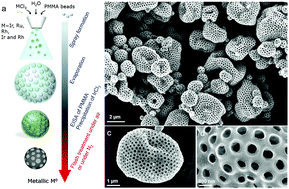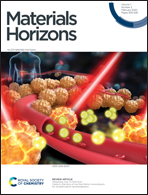Aerosol synthesis of thermally stable porous noble metals and alloys by using bi-functional templates†
Abstract
Porous noble metal nanostructures providing high surface areas and large pore volumes are attractive for numerous applications, especially catalysis. However, the synthesis of such architectures with nanoscale features is challenging because of e.g., high surface energy. Previous reports are based on multi-step synthetic approaches with low yield and are thus not compatible with an industrial scale. Herein, we demonstrate that hierarchical nanostructured noble metals and alloys, with thermal stability up to 800 °C, can be fabricated by a high throughput, green and straightforward aerosol-assisted synthesis using bi-functional reducing templates. We unravel the reduction mechanism at the solid/solid interface at the single-particle level using state-of-the-art techniques such as in situ transmission electron microscopy, and in situ synchrotron-based X-ray absorption spectroscopy. We propose a mechanism based on a radical process thermally triggered by the depolymerization of organic components. From a fundamental point of view, this study sheds light on the reduction processes of noble metals in the presence of organic compounds with important fundamental implications for catalysis and electrocatalysis.



 Please wait while we load your content...
Please wait while we load your content...